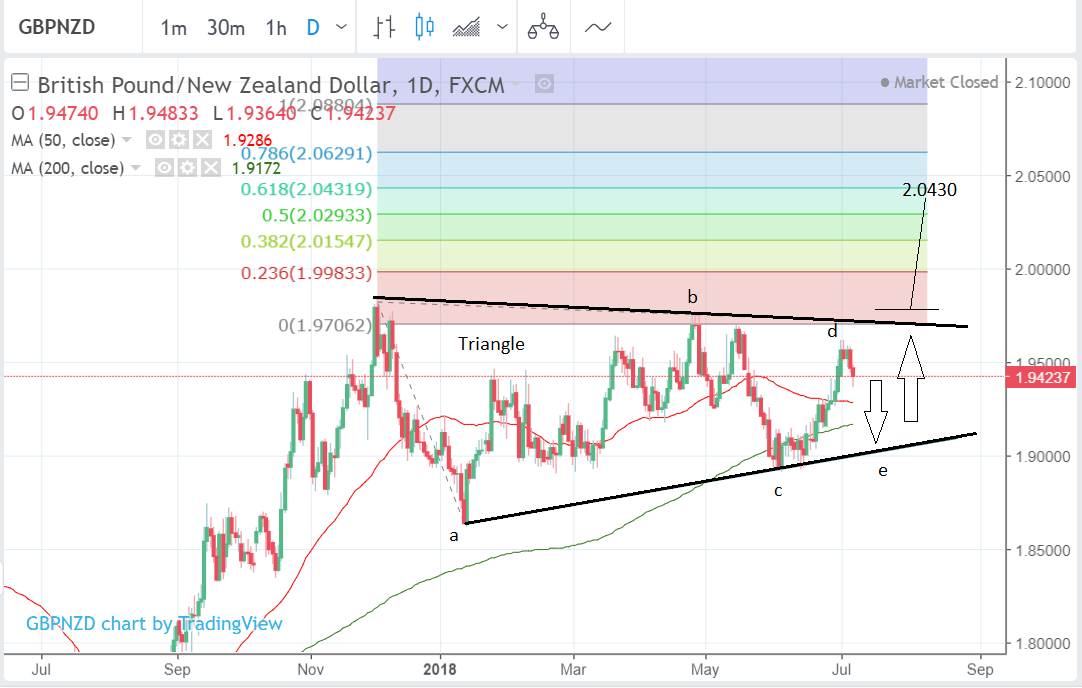Pound-to-New-Zealand-Dollar Rate Week Ahead: "Little Respite from the Sideways Grind"
-GBP/NZD continues to trade within a sideways range in 1.90s region.
-Triangle chart pattern forming with marginally bullish implications.
-Full data calendar for Pound, light schedule for New Zealand Dollar.

© Chris Titze Imaging, Adobe Stock
The Pound-to-New Zealand Dollar rate continues trading in a long and sideways range between 1.98 and 1.87, as it has done since the beginning of the year.
Although there seems little respite from the sideways grind at the moment, the exchange rate is probably forming the outline of a triangle pattern which suggests a break higher may be on the horizon.

Above: GBP/NZD shown at daily intervals.
Triangles are usually composed of a minimum of five waves, labeled a-e, so this triangle is only partially formed and appears to be in the process of completing its wave-d, with a wave-e lower the next to unfold.
The trend prior to the formation of the triangle was bullish so this marginally increases the probability the pair will break higher after its completion, although there is a possibility it could break either way.
A move above the b-wave highs at 1.9760 could confirm a breakout higher to a target at 2.0430, the target calculated from the height of the triangle at its widest point multiplied by the golden ratio of 0.618, the usual method used by technicians for establishing targets from pattern breakouts.
The possibility that Brexit risks could be easing after Theresa May and her cabinet agreed on a unified approach to Brexit provide a potential bullish catalyst for the breakout higher.
The new plan put forward by the British government maintains a frictionless border with the EU but at the same time allows the UK to freelance its own trade deals overseas collecting tariffs on behalf of Brussels for goods arriving on English shores destined for the EU.
The plan appears to provide a compromise on most of the major previous sticking points but Brexiteer purists view it as Brexit 'in name alone' as it de facto keeps the UK in the common market whilst removing its right to a veto, and there are already rumblings of descent from euro-skeptic backbenchers.
Yet for financial markets, it is likely to be received as a sensible proposal and therefore better for the economy. If it gains traction and becomes a realistic solution the Pound should bounce back in the week ahead.
The main determinant of whether the deal has longevity is the reaction of EU partners in Brussels, especially on the sticking point of freedom of movement.
One note of caution to the bullish view, however, comes from the monthly chart which is showing the 50-month MA capping price action at 1.9822.
The 50-month is a very large MA and is likely to present a tough obstacle for bulls to break above. When prices touch large MAs they are usually rebutted. The effect is often magnified by short-term traders shorting the pair in anticipation of the decline.

Above: GBP/NZD shown at monthly intervals.
Given the location of the 50-month MA we, therefore, caution against getting aggressively bullish until it has been well cleared.
Data and Events to Watch for the Pound
The reaction of the EU to Theresa's new Brexit proposal, especially that of the EU's chief negotiator Michel Barnier, will be a key issue in the week ahead for Sterling. Probably the most significant event, assuming that a reaction is forthcoming.
"While GBPUSD advanced on news that UK Prime Minister Theresa May won support for her 'soft Brexit' approach to the customs union internally, the real test is whether the EU is warm to their position," says John Kicklighter chief strategist at DailyFX.com.
Beyond that, however, it is a relatively quiet week for the Pound, with the most significant data industrial and manufacturing production, and trade data for May released on Tuesday, July 10 at 8.30 GMT.
Last week the pound was supported by strong Services PMI data for June which helped dispel fears of the Q1 slowdown extending into Q2 - the big question now is whether heavy industry experienced the same recovery and if it did it will probably support Sterling.
"A strong set of figures would almost certainly give the pound another leg up," says Rafi Bouyadjuidan, an analyst at retail broker XM.
Yet not all analysts share his view:
"The manufacturing output is unlikely to alter the view of Sterling trapped in corrective mode against the US Dollar in the week ahead," counters Mario Blascak, an analyst at FXStreet.
The other main release for the Pound is the new monthly GDP estimate (for May) out at the same time as the other data on Tuesday.
Data and Events for the New Zealand Dollar
The most important release in the week ahead for the New Zealand Dollar (Kiwi) is the Business PMI, due at 22.30 GMT on Thursday, July 11, which will provide a steer on the overall health of the business sector last month.
Business PMI came out at 54.5 in the previous month of May. A result above 50 this time would be indicative of expansion and below 50, a contraction. Another data release of note for the Kiwi is Electronic Retail Card Sales in June, which showed a rise of 0.4% in June.
Advertisement
Get up to 5% more foreign exchange by using a specialist provider to get closer to the real market rate and avoid the gaping spreads charged by your bank when providing currency. Learn more here




